#Sandy Ph
Explore tagged Tumblr posts
Text

What's your name?
#last night in soho#lnis#sandie collins#my favorite horror girl in the whole world#ph#my art#ok to rb
13 notes
·
View notes
Text




Batch '81 (1982) dir. Mike de Leon
#philippine cinema#mike de leon#mark gil#sandy andolong#ph cinema#film#filipino film#philippines#cinephile#1980s#1980s film#80s#martial law era#cinema#pelikulang pilipino#screencaps#asian cinema#pinoy cinema
0 notes
Text
Allamanda plant








#s dark yellow flowers. And this plant grows up to 15 feet tall.#allamanda cathartica plant#Allamanda blanchetti#Allamanda blanchetti is also known as purple allamanda. This variety produces a deep purple flower. And this plant grows up to 10 feet tall#allamanda blanchetti#How to grow allamanda plant#allamanda creeper growth#Soil#Allamanda survives in sandy loam soil. Excess water logging is not good for allamanda creepers. So#the PH range of soil should remain between 6.0 to 7.0. Induce the soil with organic matters like cow manure#and goat manure which provides additional nutrients to the plant. And mulching above the soil to maintain its moisture level.#allamanda plant#Water#Allamanda creeper required a minimum amount of water to survive. At the same time#allamanda is intolerant to excessive water. Watering twice a week is enough for Allamanda.#allamanda creeper#Sunlight#Allamanda plants survive in full sunlight. Allamanda flower need minimum six hours of sunligt. Ample amount of sunlight is need for proper#allamanda cathartica#Flower#Allamanda creepers produce funnel-shaped flowers with five overlapped petals that spread outwards. There are a few varieties such as allama#allamanda chocolate#and allamanda Indonesia sunset. And popular varieties of allamanda flowers are allamanda cathartica and allamanda blanchetti.#alamanda flower#Fertilizers#Give NPK fertilizer at proper ratio in the gap of 2-4 weeks. fertilizer is given at the base of the plants.#alamanda creeper fertilizer#Pruning#Early spring is better for pruning just before new growth begins. To maintain overall health and appearance pruning is an essential thing t#dead
1 note
·
View note
Text
Coleus scutellarioides









#Allamanda plant#climbers#and shrubs. It is used for traditional medicines to treat jaundice#malaria#and liver tumors.#allamanda plant#Allamanda varieties#Majorly two varieties of Allamanda are throughout the world.#Allamanda cathartica:#Allamanda cathartica is has another name called a golden trumpet. This variety produces dark yellow flowers. And this plant grows up to 15#allamanda cathartica plant#Allamanda blanchetti#Allamanda blanchetti is also known as purple allamanda. This variety produces a deep purple flower. And this plant grows up to 10 feet tall#allamanda blanchetti#How to grow allamanda plant#Allamanda shrub and allamanda creeper both are propagated through stem cuttings. Initially choose a healthy matured mother plant and cut be#allamanda creeper growth#Soil#Allamanda survives in sandy loam soil. Excess water logging is not good for allamanda creepers. So#the PH range of soil should remain between 6.0 to 7.0. Induce the soil with organic matters like cow manure#and goat manure which provides additional nutrients to the plant. And mulching above the soil to maintain its moisture level.#Water#Allamanda creeper required a minimum amount of water to survive. At the same time#allamanda is intolerant to excessive water. Watering twice a week is enough for Allamanda.#allamanda creeper#Sunlight#Allamanda plants survive in full sunlight. Allamanda flower need minimum six hours of sunligt. Ample amount of sunlight is need for proper#allamanda cathartica#Flower#Allamanda creepers produce funnel-shaped flowers with five overlapped petals that spread outwards. There are a few varieties such as allama
0 notes
Text
Allamanda plant

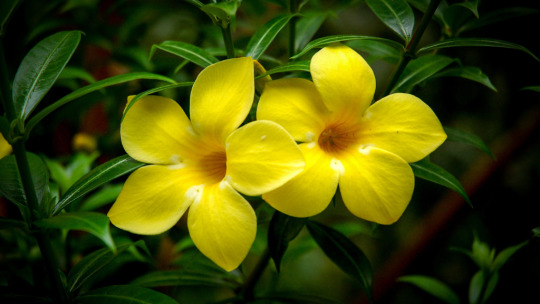

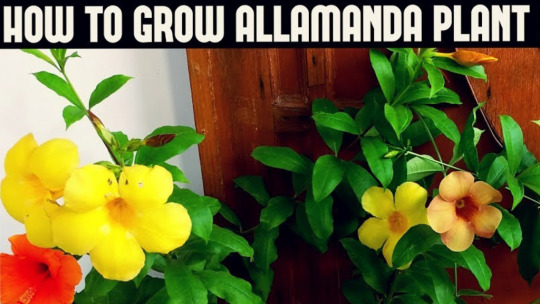
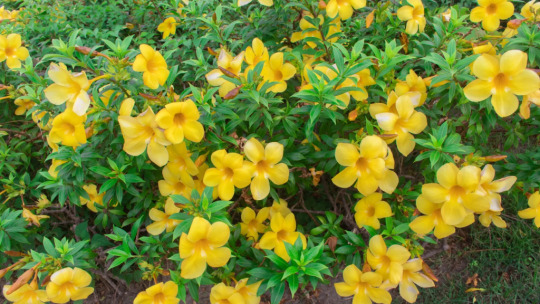


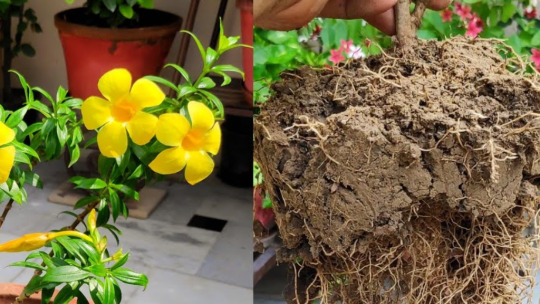
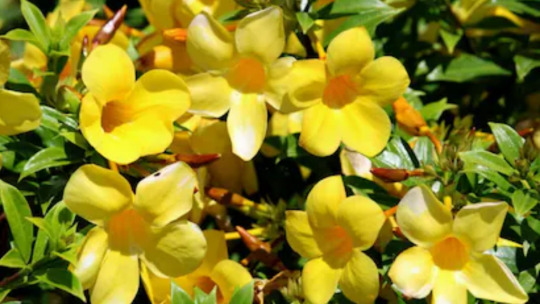
#Allamanda plant#climbers#and shrubs. It is used for traditional medicines to treat jaundice#malaria#and liver tumors.#allamanda plant#Allamanda varieties#Majorly two varieties of Allamanda are throughout the world.#Allamanda cathartica:#Allamanda cathartica is has another name called a golden trumpet. This variety produces dark yellow flowers. And this plant grows up to 15#allamanda cathartica plant#Allamanda blanchetti#Allamanda blanchetti is also known as purple allamanda. This variety produces a deep purple flower. And this plant grows up to 10 feet tall#allamanda blanchetti#How to grow allamanda plant#Allamanda shrub and allamanda creeper both are propagated through stem cuttings. Initially choose a healthy matured mother plant and cut be#allamanda creeper growth#Soil#Allamanda survives in sandy loam soil. Excess water logging is not good for allamanda creepers. So#the PH range of soil should remain between 6.0 to 7.0. Induce the soil with organic matters like cow manure#and goat manure which provides additional nutrients to the plant. And mulching above the soil to maintain its moisture level.#Water#Allamanda creeper required a minimum amount of water to survive. At the same time#allamanda is intolerant to excessive water. Watering twice a week is enough for Allamanda.#allamanda creeper#Sunlight#Allamanda plants survive in full sunlight. Allamanda flower need minimum six hours of sunligt. Ample amount of sunlight is need for proper#allamanda cathartica#Flower#Allamanda creepers produce funnel-shaped flowers with five overlapped petals that spread outwards. There are a few varieties such as allama
0 notes
Text
Allamanda plant









#Allamanda varieties#Majorly two varieties of Allamanda are throughout the world.#Allamanda cathartica:#Allamanda cathartica is has another name called a golden trumpet. This variety produces dark yellow flowers. And this plant grows up to 15#allamanda cathartica plant#Allamanda blanchetti#Allamanda blanchetti is also known as purple allamanda. This variety produces a deep purple flower. And this plant grows up to 10 feet tall#allamanda blanchetti#How to grow allamanda plant#Allamanda shrub and allamanda creeper both are propagated through stem cuttings. Initially choose a healthy matured mother plant and cut be#allamanda creeper growth#Soil#Allamanda survives in sandy loam soil. Excess water logging is not good for allamanda creepers. So#the PH range of soil should remain between 6.0 to 7.0. Induce the soil with organic matters like cow manure#and goat manure which provides additional nutrients to the plant. And mulching above the soil to maintain its moisture level.#allamanda plant#Water#Allamanda creeper required a minimum amount of water to survive. At the same time#allamanda is intolerant to excessive water. Watering twice a week is enough for Allamanda.#allamanda creeper#Sunlight#Allamanda plants survive in full sunlight. Allamanda flower need minimum six hours of sunligt. Ample amount of sunlight is need for proper#allamanda cathartica#Flower#Allamanda creepers produce funnel-shaped flowers with five overlapped petals that spread outwards. There are a few varieties such as allama#allamanda chocolate#and allamanda Indonesia sunset. And popular varieties of allamanda flowers are allamanda cathartica and allamanda blanchetti.#alamanda flower#Fertilizers#Give NPK fertilizer at proper ratio in the gap of 2-4 weeks. fertilizer is given at the base of the plants.
0 notes
Text


ashley rous @ sandy liang ss24 (ph: dillon matthew)
2K notes
·
View notes
Text
I would've made more but I'm leaving for China in 3 days so I restrained myself to succulents. The moonstone might suffer a bit without being watered for a month (it'll probably lose its flowers u_u) but the lithops are fully plumped up and actually look a bit over watered to me and I probably won't need to water them again until autumn 👍 it's my first time keeping lithops so I'm a bit nervous but I'm going to stick to watering them only twice a year. Or even once a year. Also separating the lithops took me ✨2 hours✨ last night and this is why you don't keep your succulents in peat, kids.
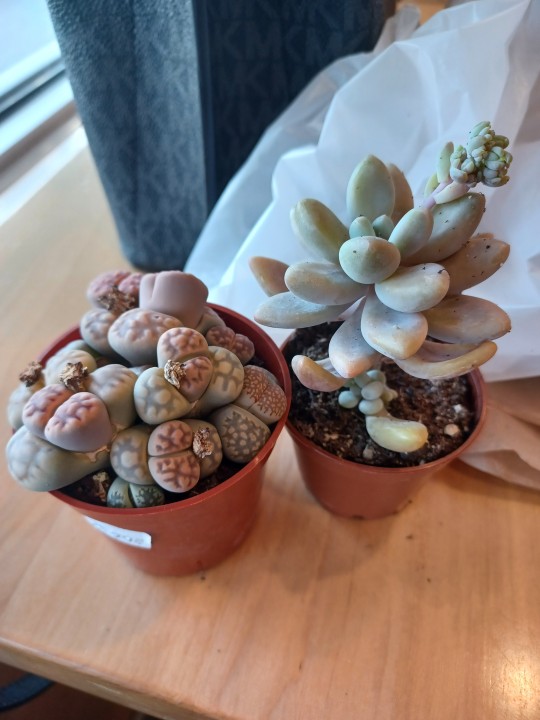
Anyway. Made some impulsive purchases yesterday.
#separating them would've gone faster if i had wetted the soil but I'm SO scared of adding unnecessary moisture to lithops#i got cactus soil but i might go to a home/garden store and get some gravel and perlite and mix in even more into the soil#because there's still peat in the perlite and im Worried about compaction and also about too much organic matter#these grow in very sandy and nutrient poor environments in the wild so too much Nutrience is not good for them#also gravel is good because it releases little bits of minerals and lowers the ph each time you water#lithops are nicknamed living rocks because they live in very rocky areas in the shade of other plants so... they feel comfy with rocks#they are the true pet rock#unfortunately i would not recommend getting this for your kids because they are so (purportedly) finicky#but who knows! maybe this is another orchid situation#plant rambles
9 notes
·
View notes
Text




backstage at sandy liang fw 2023 ph. by stolenbesos
4K notes
·
View notes
Text
BALIKTURLERİ - MEGA+ (2)

Kuhli loach are a popular freshwater aquarium species known for their unique appearance and peaceful nature. These bottom-dwelling fish have long, slender bodies with distinctive black and brown stripes running the length of their bodies. Kuhli Loaches are social creatures and should be kept in groups of at least six to eight. They are shy and sensitive and require plenty of hiding places in the aquarium to feel secure. Kuhli Loaches are omnivores and will eat a variety of foods, including algae wafers, sinking pellets, and live or frozen foods. In terms of tank requirements, Kuhli Loaches prefer a well-planted aquarium with plenty of hiding places and a soft, sandy substrate. They also require clean, well-oxygenated water with a pH between 6.0 and 7.5 and a temperature range of 75-86°F. Kuhli Loaches are peaceful fish and can be kept with other non-aggressive species, such as rasboras and tetras. However, they should not be kept with aggressive or territorial fish, as they are easily intimidated and can become stressed. When it comes to care tips, Kuhli Loaches are relatively low-maintenance fish. They do an excellent job of keeping aquariums clean by eating leftover food and other debris. However, they require a varied diet to ensure optimal health and should be fed a mix of commercial and live or frozen foods. Kuhli Loaches are also sensitive to water conditions and should be monitored closely for signs of stress or illness. Overall, with proper care and attention, Kuhli Loaches can be a fascinating and rewarding addition to any freshwater aquarium.
1K notes
·
View notes
Text
Herb Spotlight: Thyme

History & Origins
Thyme (Thymus vulgaris) is a perennial herb that has been cherished for its culinary, medicinal, and spiritual properties for thousands of years. Originating from the Mediterranean region, thyme was used by the ancient Egyptians for embalming, while the Greeks and Romans valued it for its antiseptic properties and burned it as incense in temples to purify spaces.
The name "thyme" is believed to come from the Greek word "thymos," meaning courage or strength. Roman soldiers would bathe in thyme-infused water to gain bravery before battles. In the Middle Ages, it was also tucked under pillows to ward off nightmares and given to knights and warriors as a symbol of courage.
Where & How to Grow Thyme
Thyme is a resilient, sun-loving herb that thrives in well-drained soil and can be grown both indoors and outdoors.
Climate: Thyme prefers warm, sunny climates with at least 6 hours of sunlight daily. It's drought-tolerant and does well in zones 5-9.
Soil: Grows best in well-drained, sandy soil with a slightly alkaline pH. Avoid overwatering, as thyme doesn't tolerate soggy soil.
Growing from seeds: Start thyme seeds indoors 6-8 weeks before the last frost, or plant cuttings directly in the garden in spring or early summer. Thyme can also be propagated easily by root division.
Spacing: Plant thyme about 12 inches apart in a sunny location. It can also be grown in pots or as a ground cover, as it only grows to about 6-12 inches tall.
Harvesting: Harvest thyme when the plants are dry, preferably in the morning, by cutting sprigs just before the flowers bloom. The leaves can be used fresh or dried for later use.
Health Benefits
Thyme offers numerous medicinal benefits when used orally or topically.
Oral Uses:
Respiratory support: Thyme is a natural expectorant, helping to clear mucus and ease symptoms of coughs, colds, bronchitis, and sore throats. Drinking thyme tea or using thyme honey is particularly effective.
Antimicrobial properties: Thyme contains thymol, an essential oil with antibacterial, antifungal, and antiviral properties. It helps fight infections and boost the immune system.
Digestive aid: Thyme is excellent for relieving indigestion, bloating, and gas. It can also help regulate gut bacteria and support digestive health.
Antioxidant support: Rich in vitamin C and other antioxidants, thyme helps reduce oxidative stress, supporting overall wellness and aging.
Topical Uses:
Skin health: Thyme can be used as a natural antiseptic for treating wounds, cuts, and infections. It also helps soothe skin conditions such as acne, eczema, and fungal infections due to its antimicrobial properties.
Anti-inflammatory: When applied topically, thyme can reduce inflammation and swelling, making it useful for treating skin irritations or minor burns.
Hair growth: Thyme oil is often used in natural hair care products for stimulating hair growth and treating dandruff due to its antimicrobial properties.
Magical Properties
Thyme has long been associated with purification, protection, and courage in magical practices.
Purification: Thyme is used in cleansing rituals, either burned as incense or added to baths to cleanse one's aura or energy field. It is believed to purify spaces, removing negative energies or spirits.
Protection: Thyme is often carried or placed in doorways for protection from harm or ill intentions. It can also be worn as a charm to ward off negative energies and bad dreams.
Courage & Strength: Thyme is associated with bravery. In magical workings, it’s used to summon strength and courage, especially when facing difficult situations or challenges. It can be carried as a talisman or burned before spell work to empower the caster.
Healing: Thyme is often used in spells related to healing, vitality, and renewal. It's added to healing potions, incense, and sachets to promote physical and emotional recovery.
Love & Attraction: In love magic, thyme is believed to attract love and affection. It’s often included in love sachets, charms, or baths to draw positive relationships and strengthen existing ones.
Using Thyme in Your Practice
Thyme tea: Brewed as tea, thyme can be sipped to promote healing, clear the mind, and fortify the spirit before rituals.
Burning thyme: Burn dried thyme as an offering to deities, or use the smoke to cleanse and purify spaces, objects, or yourself.
Thyme oil: Dilute thyme essential oil in a carrier oil and use it in healing rituals or anointing candles to promote health and protection.
Thyme is a versatile herb with deep roots in history, known for its medicinal, culinary, and magical uses. Whether you're growing it in your garden or using it in your magical practice, thyme offers powerful healing, protective, and purifying qualities that make it a must-have in any herbalist's or witch’s collection.
#herb spotlight#herbs#plant magic#herbalism#plant medicine#thyme#witch#witchy#witchcraft#kitchen witch#green witch#witchblr
20 notes
·
View notes
Text
Allamanda plant
The Allamanda plant is an evergreen perennial flowering plant that belongs to the family Apocynaceae. They are indigenous to America. Some varieties of allamanda yields colorful flowers. Many varieties of allamanda produce yellow flowers and few varieties of allamanda produce pink flowers. Allamanda plant usually grows up to 20 feet. Allamanda plants are classified based on their stem position such as creeper, climbers, and shrubs. It is used for traditional medicines to treat jaundice, malaria, and liver tumors.
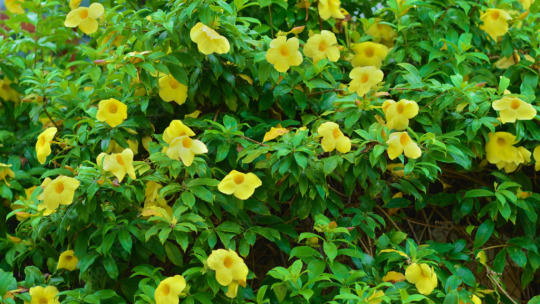
Allamanda varieties
Majorly two varieties of Allamanda are throughout the world.
Allamanda cathartica:
Allamanda cathartica is has another name called a golden trumpet. This variety produces dark yellow flowers. And this plant grows up to 15 feet tall.
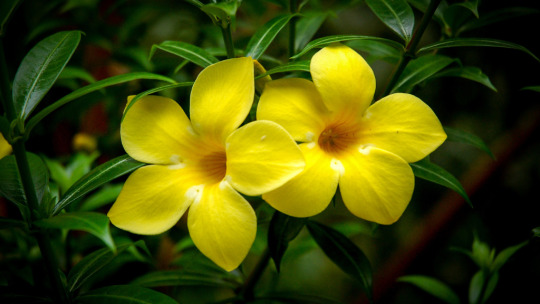
Allamanda blanchetti
Allamanda blanchetti is also known as purple allamanda. This variety produces a deep purple flower. And this plant grows up to 10 feet tall.

How to grow allamanda plant
Allamanda shrub and allamanda creeper both are propagated through stem cuttings. Initially choose a healthy matured mother plant and cut below the leaf node. While transplanting remove all the leaves from the bottom portion of the stem and leave two couple of leaves at the apical portion and place them in a pot. After 3-5 weeks roots start to generate.
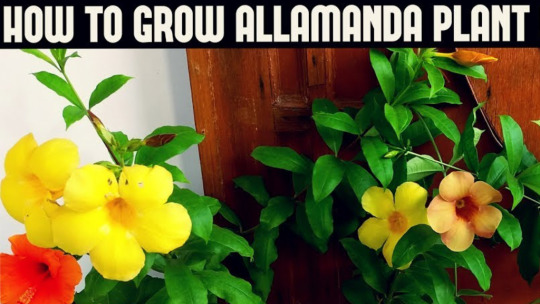
Soil
Allamanda survives in sandy loam soil. Excess water logging is not good for allamanda creepers. So, the PH range of soil should remain between 6.0 to 7.0. Induce the soil with organic matters like cow manure, and goat manure which provides additional nutrients to the plant. And mulching above the soil to maintain its moisture level.

Flower
Allamanda creepers produce funnel-shaped flowers with five overlapped petals that spread outwards. There are a few varieties such as allamanda cream, allamanda chocolate, and allamanda Indonesia sunset. And popular varieties of allamanda flowers are allamanda cathartica and allamanda blanchetti.
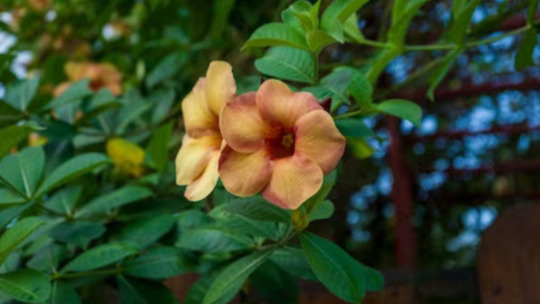
Fertilizers
Give NPK fertilizer at proper ratio in the gap of 2-4 weeks. fertilizer is given at the base of the plants.
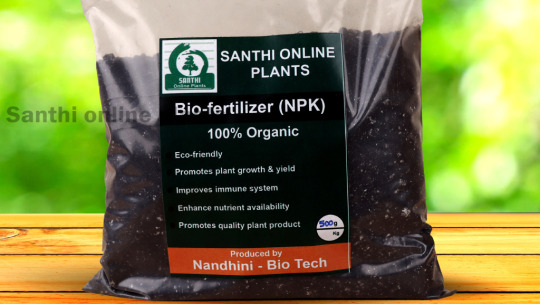
Pruning
Early spring is better for pruning just before new growth begins. To maintain overall health and appearance pruning is an essential thing that removes all diseased, dead, and damaged branches.
Usually, allamanda grows vigorously so, prune it according to your desired size.

Choose green go wild
Blog created by: www.santhionlineplants.com
#Soil#Allamanda survives in sandy loam soil. Excess water logging is not good for allamanda creepers. So#the PH range of soil should remain between 6.0 to 7.0. Induce the soil with organic matters like cow manure#and goat manure which provides additional nutrients to the plant. And mulching above the soil to maintain its moisture level.#allamanda plant#Water#Allamanda creeper required a minimum amount of water to survive. At the same time#allamanda is intolerant to excessive water. Watering twice a week is enough for Allamanda.#allamanda creeper#Sunlight#Allamanda plants survive in full sunlight. Allamanda flower need minimum six hours of sunligt. Ample amount of sunlight is need for proper#allamanda cathartica#Flower#Allamanda creepers produce funnel-shaped flowers with five overlapped petals that spread outwards. There are a few varieties such as allama#allamanda chocolate#and allamanda Indonesia sunset. And popular varieties of allamanda flowers are allamanda cathartica and allamanda blanchetti.#alamanda flower#Fertilizers#Give NPK fertilizer at proper ratio in the gap of 2-4 weeks. fertilizer is given at the base of the plants.#alamanda creeper fertilizer#Pruning#Early spring is better for pruning just before new growth begins. To maintain overall health and appearance pruning is an essential thing t#dead#and damaged branches.#Usually#allamanda grows vigorously so#prune it according to your desired size.#allamanda blanchetti plant pruning#Repotting#Repot the allamanda before its active growth begins. Choose a well-drained potting mix that is suitable for allamanda. After repotting wate
1 note
·
View note
Text
Allamanda plant
The Allamanda plant is an evergreen perennial flowering plant that belongs to the family Apocynaceae. They are indigenous to America. Some varieties of allamanda yields colorful flowers. Many varieties of allamanda produce yellow flowers and few varieties of allamanda produce pink flowers. Allamanda plant usually grows up to 20 feet. Allamanda plants are classified based on their stem position such as creeper, climbers, and shrubs. It is used for traditional medicines to treat jaundice, malaria, and liver tumors.
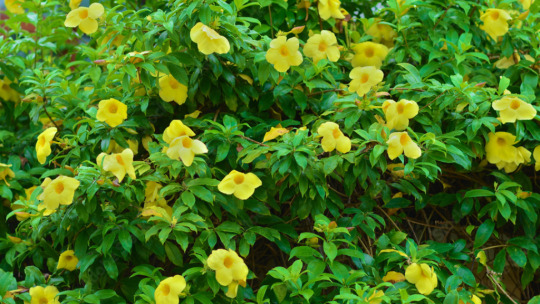
Allamanda varieties
Majorly two varieties of Allamanda are throughout the world.
Allamanda cathartica:
Allamanda cathartica is has another name called a golden trumpet. This variety produces dark yellow flowers. And this plant grows up to 15 feet tall.
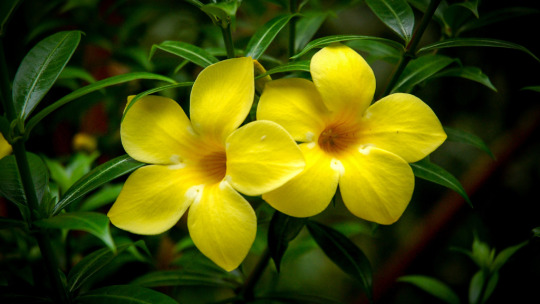
Allamanda blanchetti
Allamanda blanchetti is also known as purple allamanda. This variety produces a deep purple flower. And this plant grows up to 10 feet tall.
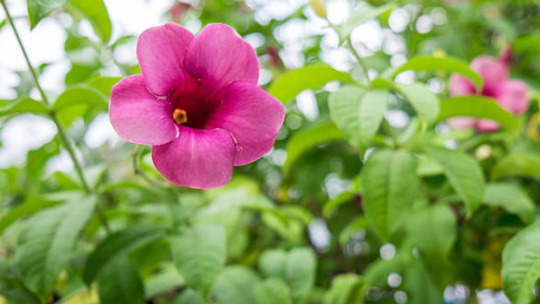
How to grow allamanda plant
Allamanda shrub and allamanda creeper both are propagated through stem cuttings. Initially choose a healthy matured mother plant and cut below the leaf node. While transplanting remove all the leaves from the bottom portion of the stem and leave two couple of leaves at the apical portion and place them in a pot. After 3-5 weeks roots start to generate
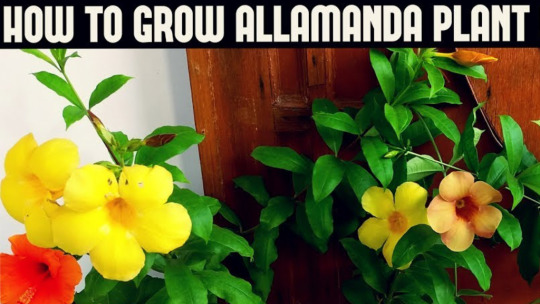
Soil
Allamanda survives in sandy loam soil. Excess water logging is not good for allamanda creepers. So, the PH range of soil should remain between 6.0 to 7.0. Induce the soil with organic matters like cow manure, and goat manure which provides additional nutrients to the plant. And mulching above the soil to maintain its moisture level.
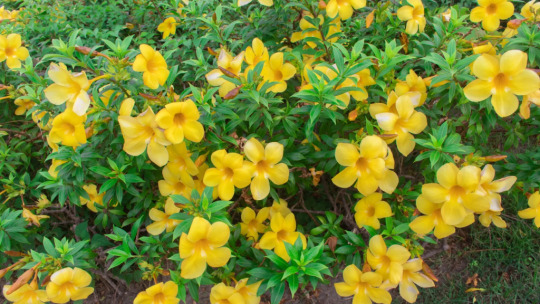
Water
Allamanda creeper required a minimum amount of water to survive. At the same time, allamanda is intolerant to excessive water. Watering twice a week is enough for Allamanda.
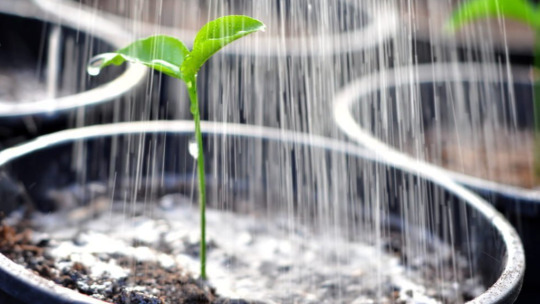
Benefits of allamanda
Allamanda blanchetti are praised for colorful shades and trumpet shape.
Allamanda flower attracts pollinators which promotes a healthy ecosystem.
In traditional medicine, many parts of allamanda are used for various purposes. Allamanda is highly used to treat skin infections, fever, and certain stomach issues.
Allamanda flower possesses some anti-inflammatory properties which reduce inflammation.
Plants play a vital role in purifying the air, providing oxygen and it creates a healthier ecosystem.
Allamanda-flower plant
Choose green go wild
Blog created by: www.santhionlineplants.com
#Soil#Allamanda survives in sandy loam soil. Excess water logging is not good for allamanda creepers. So#the PH range of soil should remain between 6.0 to 7.0. Induce the soil with organic matters like cow manure#and goat manure which provides additional nutrients to the plant. And mulching above the soil to maintain its moisture level.#allamanda plant#Water#Allamanda creeper required a minimum amount of water to survive. At the same time#allamanda is intolerant to excessive water. Watering twice a week is enough for Allamanda.#allamanda creeper#Sunlight#Allamanda plants survive in full sunlight. Allamanda flower need minimum six hours of sunligt. Ample amount of sunlight is need for proper#allamanda cathartica#Flower#Allamanda creepers produce funnel-shaped flowers with five overlapped petals that spread outwards. There are a few varieties such as allama#allamanda chocolate#and allamanda Indonesia sunset. And popular varieties of allamanda flowers are allamanda cathartica and allamanda blanchetti.#alamanda flower#Fertilizers#Give NPK fertilizer at proper ratio in the gap of 2-4 weeks. fertilizer is given at the base of the plants.#alamanda creeper fertilizer#Pruning#Early spring is better for pruning just before new growth begins. To maintain overall health and appearance pruning is an essential thing t#dead#and damaged branches.#Usually#allamanda grows vigorously so#prune it according to your desired size.#allamanda blanchetti plant pruning#Repotting#Repot the allamanda before its active growth begins. Choose a well-drained potting mix that is suitable for allamanda. After repotting wate
0 notes
Text
Cordyline fruticosa
The Cordyline fruticosa plants are most beautiful eye-catching evergreen perennial plants with broad leaves. Plant foliage varies in different colors such as red, pink, yellow, white & other streaks.
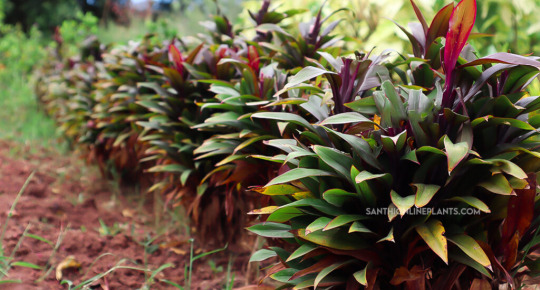
Good Luck plant
These cordyline fruticosa plants are commonly called Hawaiian ti plant, good luck plant, ti plant, palm lily, cabbage palm, and miracle plant belonging to Asparagaceae. This plant is often believed to bring good luck to the home.
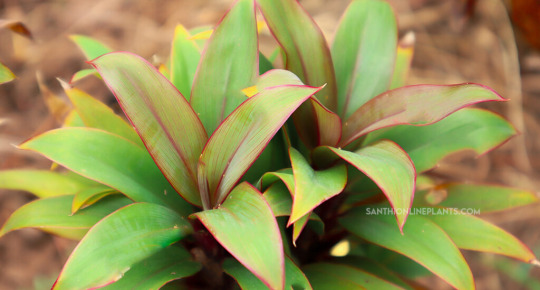
Hawaiian ti plant
This cordyline plant variety prized & beloved especially for its colorful, long-lasting foliage with attractive stripes. The name Hawaiian ti plant name due to the reason that this croton plant believed to bring positiveness, creation, and blessing during those times in Hawaiian culture.
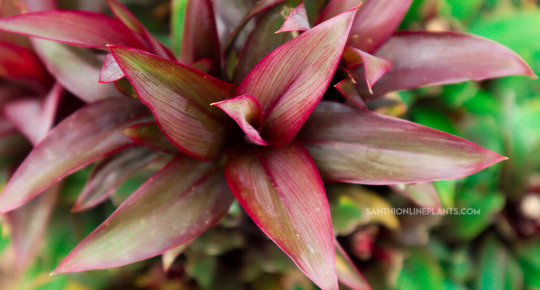
Ti- plant Varieties
This croton plant variety range from about 100+ plants. Among those the most popular varieties such as Cordyline congesta, cordyline rumba, cordyline kiwi, black magic, australis purpurea, Lemon-lime, miss andrea, red Ruby, celestial queen, & Hybrid ti.
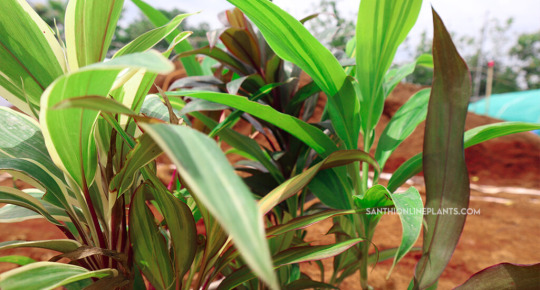
Cordyline congesta
This croton plant variety has attractive dark-colored foliage with smooth, glossy broad leaves. It is fast growing plant with a woody stem.
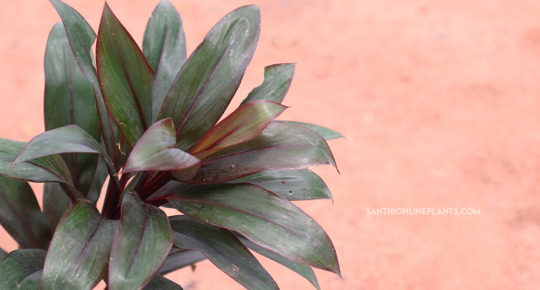
Benefits
The placement of ti -plant croton plant is believed to bring good luck, peace and positivity to home.
Cordyline Ti plants are pests & diseases resistant plants.
The most beautiful feature of this plant is the colorful foliage & air-purifier.
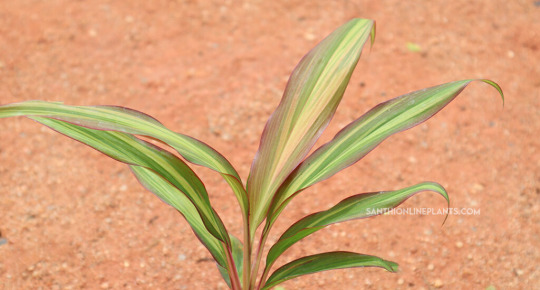
Cordyline fruticosa-ti plant crotons
Blog Completed By: Santhionlineplants
#t is fast growing plant with a woody stem.#ti plant congesta#Cordyline rumba#The most attractive ornamental plant grows like dracaena plants with wide long leaves. The foliage color seems to be dark green with pink s#croton plant#Andrea#This Hawaiian ti plant has a wide range of creamy yellow stripes which make the environment look eye-catching. This ti plant placement can#hawaiian ti plant#Care & Maintenance#Soil#This cordyline ti plant loves to grow in a wide range of fertile soil preferably acidic pH. Soil may be sandy loam#clay#or coco peat potting mix.#soil#Watering#This good luck plant requires regular intervals of watering during the summer season. Minimize watering the cordyline plants during the win#watering for ti plant#Sunlight#Sunlight requirement for this variety is direct sunlight of 4-5 hours with partial shade. Too much light may fade some variegated cordyline#sunlight#Propagation#This croton variety propagated through the methods such as Tip cuttings#Stem cuttings & Air-layering.#Tip Cuttings#From mature plants take the tip cuttings. Take tip cuttings from 3-4 cm of the plant. And plant the cutting in potting mix or soil.#Stem Cuttings#Take 3-4’ cuttings from the matured plant just below the node of the plant and place the plant in the prepared potting mix.#stem cuttings#Placement#The placement of this plant in both indoor & outdoor environments.
0 notes
Text
Cordyline fruticosa
The Cordyline fruticosa plants are most beautiful eye-catching evergreen perennial plants with broad leaves. Plant foliage varies in different colors such as red, pink, yellow, white & other streaks.
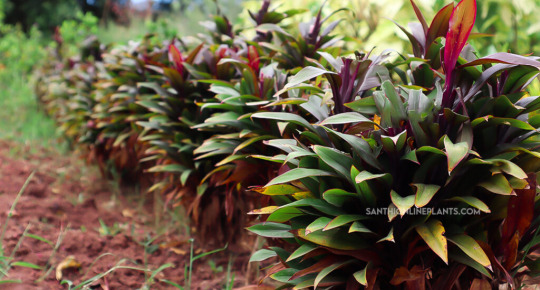
Good Luck plant
These cordyline fruticosa plants are commonly called Hawaiian ti plant, good luck plant, ti plant, palm lily, cabbage palm, and miracle plant belonging to Asparagaceae. This plant is often believed to bring good luck to the home.
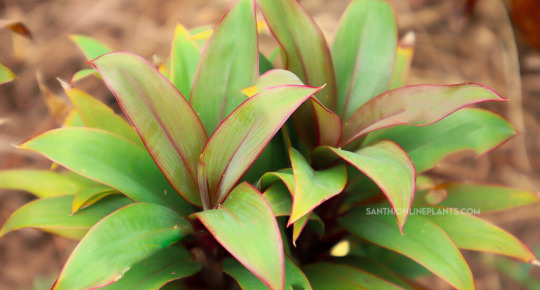
Hawaiian ti plant
This cordyline plant variety prized & beloved especially for its colorful, long-lasting foliage with attractive stripes. The name Hawaiian ti plant name due to the reason that this croton plant believed to bring positiveness, creation, and blessing during those times in Hawaiian culture.
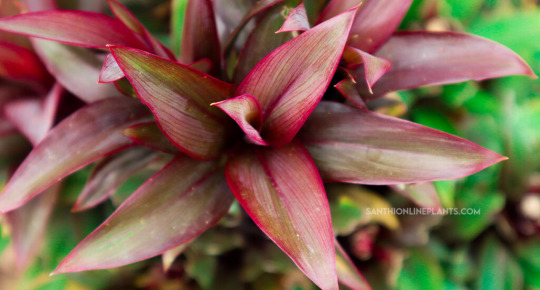
Ti- plant Varieties
This croton plant variety range from about 100+ plants. Among those the most popular varieties such as Cordyline congesta, cordyline rumba, cordyline kiwi, black magic, australis purpurea, Lemon-lime, miss andrea, red Ruby, celestial queen, & Hybrid ti.
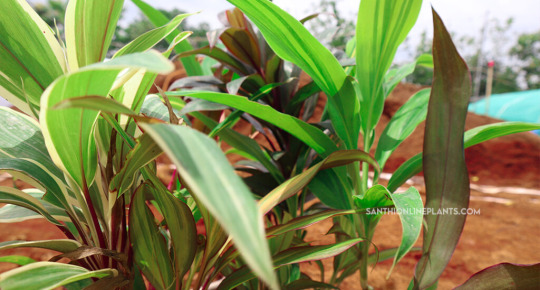
Cordyline congesta
This croton plant variety has attractive dark-colored foliage with smooth, glossy broad leaves. It is fast growing plant with a woody stem
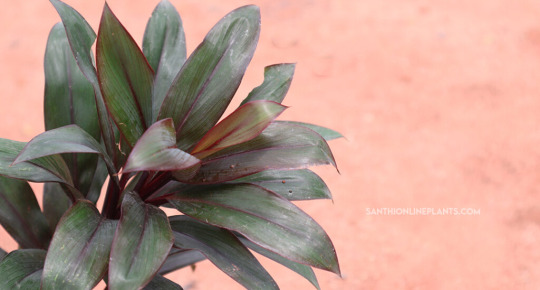
Fertilizer
Application of any organic fertilizer or well-decomposed manure around the plants helps to grow this croton plant bushy clump & wide in appearance.
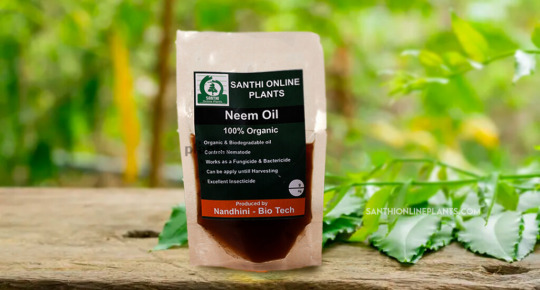
Benefits
The placement of ti -plant croton plant is believed to bring good luck, peace and positivity to home.
Cordyline Ti plants are pests & diseases resistant plants.
The most beautiful feature of this plant is the colorful foliage & air-purifier.
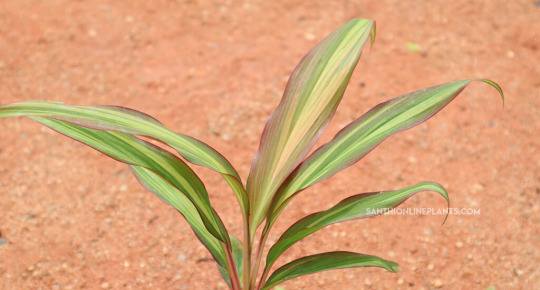
#Cordyline congesta#This croton plant variety has attractive dark-colored foliage with smooth#glossy broad leaves. It is fast growing plant with a woody stem.#ti plant congesta#Cordyline rumba#The most attractive ornamental plant grows like dracaena plants with wide long leaves. The foliage color seems to be dark green with pink s#croton plant#Andrea#This Hawaiian ti plant has a wide range of creamy yellow stripes which make the environment look eye-catching. This ti plant placement can#hawaiian ti plant#Care & Maintenance#Soil#This cordyline ti plant loves to grow in a wide range of fertile soil preferably acidic pH. Soil may be sandy loam#clay#or coco peat potting mix.#soil#Watering#This good luck plant requires regular intervals of watering during the summer season. Minimize watering the cordyline plants during the win#watering for ti plant#Sunlight#Sunlight requirement for this variety is direct sunlight of 4-5 hours with partial shade. Too much light may fade some variegated cordyline#sunlight#Propagation#This croton variety propagated through the methods such as Tip cuttings#Stem cuttings & Air-layering.#Tip Cuttings#From mature plants take the tip cuttings. Take tip cuttings from 3-4 cm of the plant. And plant the cutting in potting mix or soil.#Stem Cuttings#Take 3-4’ cuttings from the matured plant just below the node of the plant and place the plant in the prepared potting mix.#stem cuttings
0 notes
Text
Submitted via Google Form:
Hi, I'd like to build a planet with land across the entire planet that is mostly an alpine. I'm thinking that the majority of the land will be tall mountains with almost all shorelines being tall cliffs so even areas close to the ocean can quickly become tall mointains. Places near the equator will have the highest mountains to offset being closer to the sun. How about resources though? What would be abundant, what puld lack? How about other geographical features and conditions that allow a planet to look like this?
Tex: What happens when the tectonic plates meet? Mountains are created via only one type of plate movement (Wikipedia), but due to physics the opposite side of that plate would create the opposite result (Wikipedia). In order to dissipate the forces caused by a plate causing convergent and divergent boundaries, the horizontal movements of a transformation fault would develop (Wikipedia).
Resources can be boiled down to approximately two things: what grows in water, and what grows in soil. For the former, oceans, seas, lakes, and related areas would need to exist and be large enough to develop life of higher trophic levels. For the latter, it would need enough erosion of rocks to create soil, and be propagated by bacteria to facilitate a healthy environment to propagate photosynthetic life and the upper trophic levels that rely on it. (Birds exist, but also birds must roost, so for all intents and purposes they rely on what grows in soil.)
Anything that has above-water places high enough to create what we would subjectively perceive as mountains would have to be an extremely geologically-active planet, where the plates are constantly moving. This would mean things like lots of volcanoes, and likely an atmosphere saturated in gases like sulfur. Extremophiles can grow in these conditions, but because of energy conservation in a geologically-hostile environment, they’re not likely to grow very big.
If you wish for something different, it might be a “dead” planet, in which there’s little geological activity and the state of things like mountain ranges and placement of oceans are effectively locked into place. This would mean an inert core, and possibly a dying planet or else one in a solar system where it’s faced with a dying sun or outside the goldilocks zone of a reasonably active sun.
Addy: So, resources. That's my jam. If you've got a heavily alpine area, you're generally on mountains or mountain slopes, which generally means you're going to be on a whole bunch of rock. That rock could be sedimentary or metamorphic (igneous is also possible, basalt mountains do exist), but it's still rock. Things that rely on heavy amounts of soil - sand, clay, loam, otherwise - will struggle to form into industries.
You might have 3-4 feet of soil ("soil" includes sections that are mostly gravel – if you're looking for dirt, probably only a foot or two). Looking at a couple examples, I'd say you're probably going to get sandy loam, loamy sand, and gravelly loam. Great drainage, not good for food crops. Since you're alpine, that's going to mean you're above the tree line, so timber is going to be scarce as well. Neutral pH to somewhat alkaline, if that matters to ya. Also, above the tree line, the winds get to be very, very harsh - harsh enough that most plants can't survive up there, so crops are doubly not an option.
If you've got a freeze-thaw cycle, then the ground is going to sprout rocks every year in the spring (literally, the freeze-thaw cycle pushes rocks up towards the surface from under the ground, so you get new rocks in your fields every spring as it starts to thaw), so stone for walls and homes will be plentiful. Insulation will likely come from packed earth (e.g. Icelandic turf homes) or animal hides (e.g. yurts). Without good soil for growing, you're going to likely see a lot of animal husbandry - yaks, goats, oxen, and sheep. Maybe small horses, but no large horses; large, Western horse breeds don't do well if they're only grazing - they generally have feed grown for them. Draft horses are large enough that they have to have food grown for them. But ponies are an option.
Your sand will likely be difficult to get separated from the loam/gravel, so glass will be a tricky industry. Clay will be hard to find, so pottery is limited. Also limiting those industries is a lack of easily available fuel - without timber or peat, you've got limited options on what you have available to burn.
If, by alpine, you're also talking about mountain slopes (and maybe valleys?), then you'll have lots of timber. Lots and lots and lots of timber, so long as you don't clear-cut. Berries will be plentiful in the spring and fall, you'll generally have a decent supply of water, you can grow crops if you're careful about your growing seasons (and the ground acts as a refrigerator, so root cellars and similar structures act as a way to preserve food through the winter months), and you've got wild game to supplement.
Animal husbandry is still an option, though you'll almost certainly need to grow feed to keep them fed over the winter. Goats would do better than sheep, I think, but birds (chickens, ducks, partridge, geese) would probably be the easiest animal to raise. With birds, you'll also get down, which will help for quilts and bedding to keep yourself warm at night. Sheep/goats will get you wool, which will be good for clothing to keep warm. If you've got different animals, whatever birds/mammals they've got nearby that can fill the niche.
For fuel, you've got wood and charcoal. Charcoal is made from wood, and it burns hotter and cleaner than wood. Good for large kitchens… or for kilns. Or for metalworking. Or for writing/art. Wood is easier to get, and more suitable to everyday use.
Valleys tend to accumulate clay, gravel, or sand, depending on how fast the water flows. Steep slopes mean fast water, so you'll mostly get gravel. Mild slopes mean slow water, so you'll get a lot of clay (such as many river deltas, where they meet the ocean). Moderate slopes mean medium-speed water, so you'll get sand (or sand with gravel). River sand may not get you high-quality glass, but you can still make basic glass out of it. When the rivers freeze in the winter, you'll have lots of ice. That can be stored underground in ice houses, so that you have ice year-round.
For lime/quicklime, you'll need shells (so beach) or limestone (so depends on mountains type). Lime is used for a variety of things - making mortar for bricks, removing impurities when making iron, making concrete, etc - but you need limestone (or shells, like oyster shells) and fuel to make it. So that really depends on the type of stone the mountains are made of.
Salt may or may not be plentiful, depending on what the mountains are made of. You've got very little ocean access (since cliffs), so drying out seawater for salt isn't going to be effective for large-scale production.
Either way (with or without trees), trade will be difficult. Overland trade will have to deal with snow, ice, and uneven terrain (plus possible food issues for pack animals). Sea-based trade would have to deal with getting goods up or down those massive cliffs without damaging or dropping them.. and also getting people down there, too. Huge altitude changes.
Wootzel: If your main concern is having your planet chilly, you could look at Earth during the last ice age as inspiration. This would probably result in having a planet with a LOT of nigh-unlivable area near the poles, but it could be a way to make most of your land quite cold without having to rely as heavily on high altitudes, if that’s something you want to look into.
18 notes
·
View notes